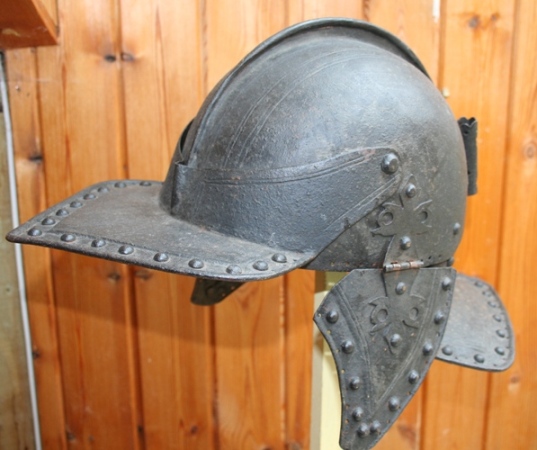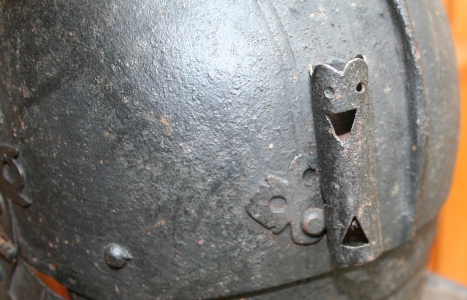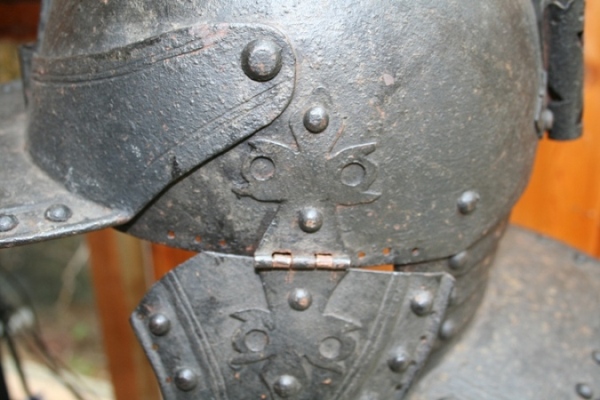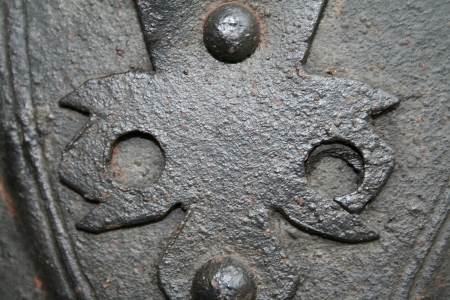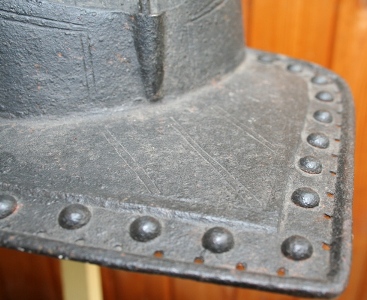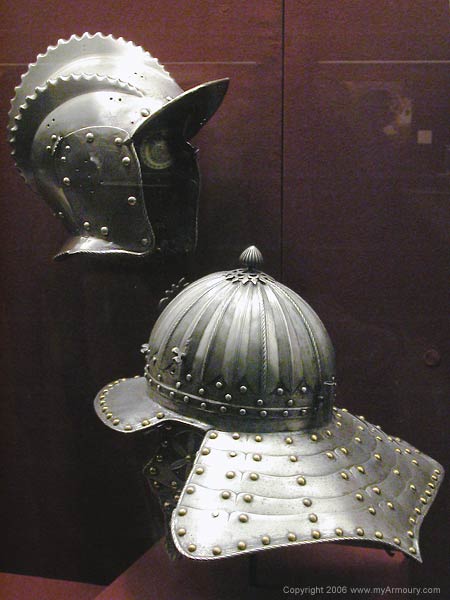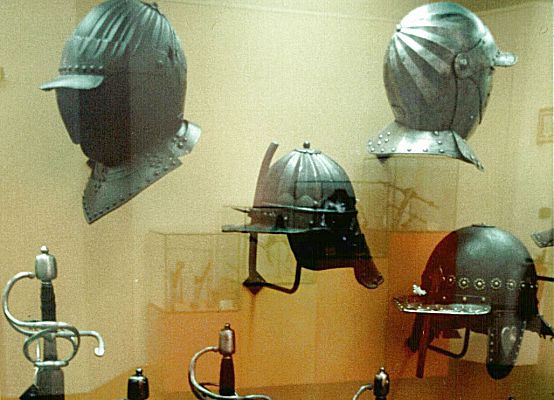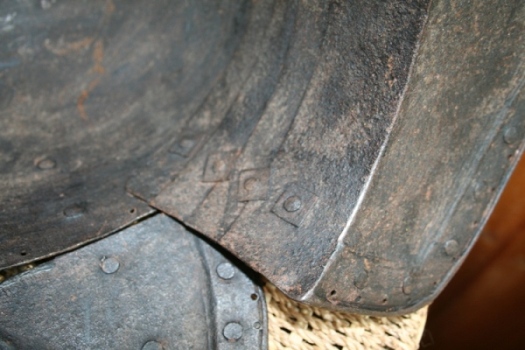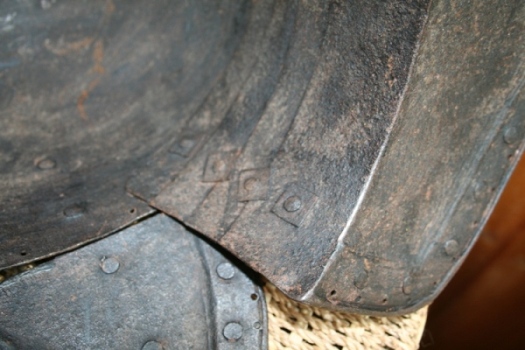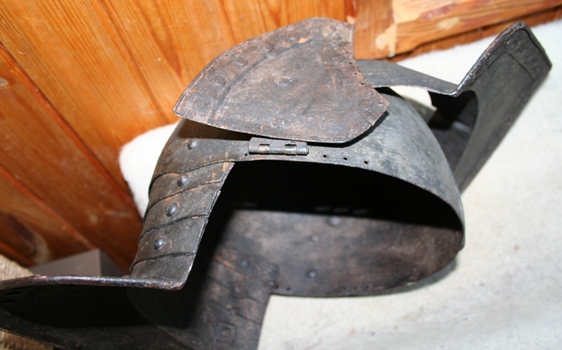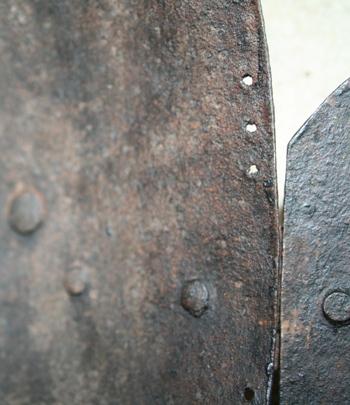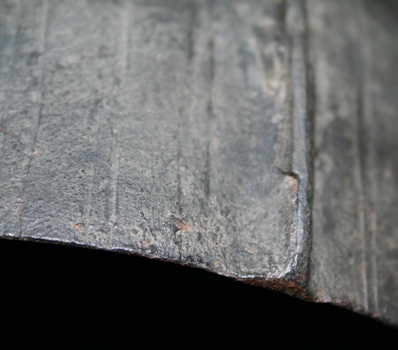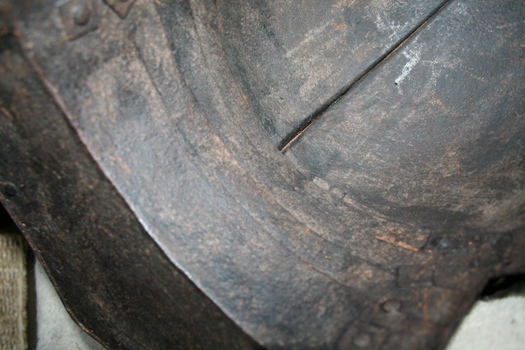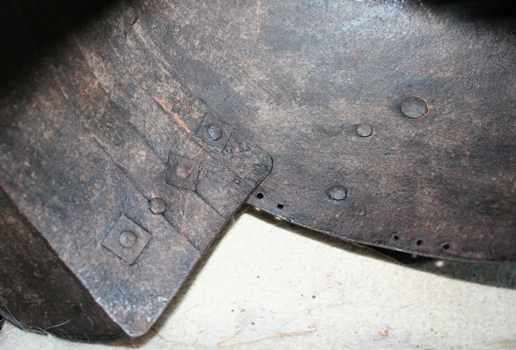Posts: 8 Location: Devon
Mon 23 Jul, 2007 9:17 am
English Civil War Helmet
Last edited by Paul Biddle on Mon 23 Jul, 2007 9:30 am; edited 1 time in total
Posts: 8 Location: Devon
Mon 23 Jul, 2007 9:24 am
Posts: 38 Location: Devon,England
Mon 23 Jul, 2007 10:12 am
English Civil War Helmet
Hi Paul,
I'm not really an armour expert but looking at style and finish I'd say it looks like a Victorian display piece. Lets wait and see what others think as well.
I should also add welcome !
Cheers
Richard
Posts: 155
Mon 23 Jul, 2007 10:44 am
Re: English Civil War Helmet
| Richard Wells wrote: |
Hi Paul,
I'm not really an armour expert but looking at style and finish I'd say it looks like a Victorian display piece. |
Could you be more specific about why you think this?
To me it the style looks 17th Century.
Posts: 1,001 Location: Roanoke,Va
Mon 23 Jul, 2007 11:38 am
Does fall with in the 17th c. style of things. Not much of an armour person either, but seems to be somewhere
between an English 3 bar lobster pot and a Scottish
burgonet. From the looks of it....at one time it should have had the sinlge nose bar/ /guard coming down through the front visor.
As far as actual age and a value......leave that to someone more up on their armour / helm studies......
Bill
Posts: 5,981 Location: Birmingham, Alabama
Mon 23 Jul, 2007 11:46 am
I disagree about the potential for a nasal. There's a ridge at the back of the peak to match the ridge of the bowl, but no way to insert or secure a nasal. As for authenticity--I think this could be mid 17th. I'm always suspicious of decoration on workaday helmets, but some of these late helmets were elaborately decorated with rivets, fluting, etc. Some have these very long peaks, too. Overall, I'd say it's either 17th or a good 19th c. piece.
Posts: 1,563 Location: Upstate NY
Mon 23 Jul, 2007 11:51 am
Do you have some pics of the inside? The basic helmet layout is that of a casquettel burgeonette but with a very 17th century feel in terms of the decoration. How much does the helmet way?
Posts: 5,981 Location: Birmingham, Alabama
Mon 23 Jul, 2007 11:54 am
Posts: 5,981 Location: Birmingham, Alabama
Mon 23 Jul, 2007 12:07 pm
I'll commit to saying it's authentic (17th c.). The condition, construction, quality, shape of the peak, lining holes at the edges and plume holder just seem too "right" to me. It would seal the deal for me if I could see what lining or trace of lining remains in the bowl. A piece made to hang on a wall needs no lining and a 19th c. piece made with an historically appropriate lining and sold to a wealthy collector should have it's lining in good condition. I'd want to see a simple lining in bad condition or just remnants under the rivets. You'd really be going the extra mile as a 19th c. forger to install a lining, then rip it out.
A theatrical helmet would probably have some kind of simple lining and might be in bad condition, but I wouldn't expect to see such a specific and late helmet design on the stage. I wouldn't be surprised to see a helmet of this style made cheaply for early cinema, but I think there's too much detail on this example to suggest that use.
Posts: 1,001 Location: Roanoke,Va
Mon 23 Jul, 2007 12:30 pm
Sean,
I see now your reason for the correction of my nasal bar theory.............(like i said...not much on my armour ID)....the ridge I first thought may accommidate the bar is actually to allow the visor and tail piece to be moved up & down the central ridge of the helmet.
Bill
(ps..I'll just stick to my mortuary's :) .............)
Posts: 38 Location: Devon,England
Mon 23 Jul, 2007 2:59 pm
English Civil War Helmet
Martin,
Just picked up your post.
As I said - I'm not an expert, but I supose I didn't feel the hinge was right - different sort of decoration to the rest of the
helmet. Also a bit cynical, and bearing in mind the popularity and profusion of 19th century items around, more than a bit
cautious !
Very interseting remarks about the lining - that would help.
Richard
Posts: 8 Location: Devon
Mon 23 Jul, 2007 11:37 pm
Posts: 5,981 Location: Birmingham, Alabama
Tue 24 Jul, 2007 7:11 am
Hmmm....doesn't look like there was ever a lining/band under the rivets visible here. However, those holes at the edges of the helmet clearly are intended to hold a lining. Stiching and glue might have been an historic lining method for this late period, but I just don't know. If I was giving this piece a 7 out of 10 on the authenticity scale, I'm now leaning more toward a 6 until somebody can tell us about Zischagge linings. :D
Posts: 1,563 Location: Upstate NY
Tue 24 Jul, 2007 7:56 am
Sean, my thought was either stiching or staples. The use of staples seems to have come into use in the 16th century from what I can tell, and used staples run through small holes in the helmet and through the lining band to hold it in. My guess is that it made replacing the lining easier than cutting out or punching out rivets. Typically however the holes for stapling are in pairs with some distance seperating the pairs and the holes in this helm are are running in a continuos string so a sewn in lining is very possible. The helmet, based on the appearence of the medial ridge seems to indicate that the bowel is made in two halves and crimped and flush riveted together but I can't see any flushed rivets or seam at the front or back of the helmet where the ridge ends ( in fact it appears that the back might almost have been cut down and the neck line of the bowel goes through the ridge). Is there a part of the helmet bowel under/behind the flange of the brim where the two halves of the bowel over lap eahc other and there is a rivet or two run through?
Posts: 250 Location: Irvine Spectrum, CA
Tue 24 Jul, 2007 9:13 am
Allan, is it possible that the front ridge terminus area was welded somehow, in period? It looks filled in or solid to me, for about 1 to 1 1/2 inches. An inside detail shot of the area would help. The rear terminus does look truncated like you said, but the atttached lames should strengthen that particular juncture, even without a rivet.
The metal working techniques do seem correct for a munitions grade piece from the seventeenth century...
Posts: 8 Location: Devon
Tue 24 Jul, 2007 9:48 am
Thanks for all your imput will check an photo some more detail, I took the helmet in payment for a debt , I collect pre WW1 German, and so was interested to see if it is "ok" , again thanks, Paul
Posts: 1,563 Location: Upstate NY
Tue 24 Jul, 2007 9:52 am
Torsten, it is possible, i've just never seen period example done that way. I did own a Victorian era Lobster Tailed Burgeonette that had been made in that fashion. I'm pretty well with Sean on this, 6-7 on the original piece scale and everything else on it seems to pretty well jibe, the lap riveted seem( or lack thereof) is the only thing that hits me because i've not encountered it before.
Posts: 8 Location: Devon
Tue 24 Jul, 2007 12:58 pm
Posts: 229 Location: Rotherham, West Riding
Tue 24 Jul, 2007 2:49 pm
Helmet
Those square washers make me go "Hmmm........." I'm increasingly tempted to say part 17th Century, part messed around 19th Century armourer" There's bits that make me think that this is 17th Century and bits that make me think..."That 'looks' wrong" If there had been square washers within the helmet bowl as I'd be happy, but on the tail, with no signs of anything under them? But that tail just looks so badly wrong I just don't buy it.
Look at this example here :-
http://www.metmuseum.org/toah/hd/ufarm/hob_14.25.611.htm
or
http://www.metmuseum.org/toah/hd/ufarm/hob_14.25.611_av1.htm
which shows a helmet with its lining
or
http://www.tuerkenbeute.de/sam/sam_lud/D1aud_de.php
with a red lining
Or these three here
http://www.thomasdelmar.com/Catalogues/as260607/page11.htm
Or these made by Nigel Carren
http://www.nigelcarren.co.uk/reproduction-armour-shop.php
Posts: 1,563 Location: Upstate NY
Tue 24 Jul, 2007 4:50 pm
I've seen square cut washing used to back articulating rivets rather than hold in a lining band on lots of stuff, I fact a fair number of original pieces I own or have owned have roughly square cut washers ( also hexagonal and filed rougly round) so that doesn't throw me. The location of the little holes around the perimeter of the brim, cheek plates, tail and bowel are in the right location to have the helmet lined incliding the brim as in the second image David posted if they are in fact stiching holes. The medial ridge appears at first to be of crimped form commonly used in the late 16th and 17th century to join two piece helmet bowels together although the close up of the ridge in front and back seems to indicate that it is welded. I at one time owned a morion that had been constructed from two halves and forgewelded along the medial ridge and ground smooth so I can't dismiss the possibility that this helmet was constructed in that way but why make it look like its a crumped and flush riveted bowel? I'm still in the 6-7 original range, the only other thing I will add is that the hinging rivets for all the original helmets i've owned were washered and I notice this one isn't. I don't know that it measn anything either way but its just something I noticed.
You
cannot post new topics in this forum
You
cannot reply to topics in this forum
You
cannot edit your posts in this forum
You
cannot delete your posts in this forum
You
cannot vote in polls in this forum
You
cannot attach files in this forum
You
can download files in this forum
